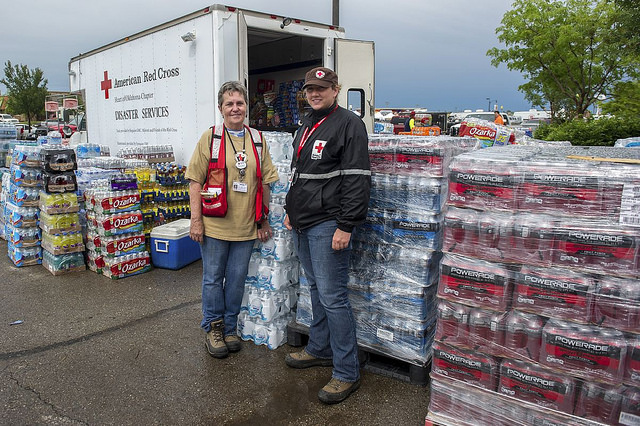Posted by: Roberto L. Hylton, Senior Law Enforcement Advisor
If you have ever had the chance to speak with Administrator Fugate or listen to him discuss the role of first responders in disasters… you will know he views their work with a revered appreciation. They are an intricate part of the emergency/disaster response team. As a former Police Chief, I can attest to their hard work and dedication and agree whole heartedly with Administrator Fugate.
In my 30 year career I have witnessed heroic efforts by my officers and colleagues, including during times of disasters. While serving Prince George’s County, we responded to 9/11, Hurricane Isabel, snowstorms, and multiple tornadoes. Specifically, I recall one of the tornadoes that impacted my county. An EF-3 tornado impacted the nearby college campus and devastated neighborhoods and infrastructure. Emergency services were stretched to the max. Our officers worked relentless hours, 48 hours straight in some cases, setting up and supporting emergency response and rescue operations. The scene was chaotic with debris and terrified college students, but the right training helped officers maintain public safety and conduct lifesaving missions.
Over the last two years I have had the distinct privilege of sharing the Administrator’s views with the law enforcement community and recently, he reflected on Law Enforcement’s Role in Responding to Disasters in an article in Police Chief Magazine:
We ask a tremendous amount of our first responders during disasters and emergencies. They are the first line of defense; they are the first helping hand extended to survivors. Every police officer knows emergencies can happen without notice. Our ability to respond to and recover from disasters is directly influenced by how well prepared our first responders are and how well we all work together as a team before, during, and after a crisis.
The role of law enforcement in responding to a disaster is very similar to the day-to-day role of public safety and supporting the community. In preparing for a disaster, police officers trust in their training and capitalize on their knowledge of a community. Exercises portraying the situations (large- and small-scale events) help better prepare officers and allow them to fully understand the resources needed for each event and apply that information to each community’s needs. Law enforcement officials know their communities best and interact with residents on a daily basis. This knowledge gives them the ability to provide valuable situational awareness to response and recovery groups coming in to help. For example, where will there be language barriers? Does the community have unique challenges? Law enforcement can help communicate this information to the emergency management team and can offer support to other members of the team by simply being a presence in the neighborhoods.
During a disaster, police officers play a key role in many operations including: search and rescue, evacuations, door-to-door checks, and maintaining overall public safety within the community. These are critical actions that support not only their own communities but neighboring towns as well.
As the Administrator explained in the article, the law enforcement community has two vital roles in responding to disasters:
- As first responders during times of crisis, and
- Providing for the safety and security of the community.
Responding to disasters is a shared responsibility, and those in law enforcement are aware that emergency management planning is for all hazards and that it takes a team effort to keep our communities safe. I’m proud to represent the law enforcement community at FEMA as we continue to strengthen the coordination among the entire emergency management team.
Editor’s Note: Police Chief Magazine is a publication from the International Association of Chiefs of Police and serves as the professional voice of law enforcement and supports programs and research, as well as training and other professional services for the law enforcement community.


 Miami, Fla., May 31, 2013 — FEMA Administrator Craig Fugate speaks at NOAA’s annual Atlantic Hurricane press event discussing the upcoming hurricane season.
Miami, Fla., May 31, 2013 — FEMA Administrator Craig Fugate speaks at NOAA’s annual Atlantic Hurricane press event discussing the upcoming hurricane season. Moore, Okla., May 27, 2013 — Disaster Survivor Assistance Team (DSAT) member, Kathleen King and FEMA Corps member, Ana Canizales canvas the Whispering Oaks area of Moore. They are providing disaster related information and taking FEMA disaster assistance registrations. The Moore area was struck by a F5 tornado on May 20, 2013. Andrea Booher/FEMA
Moore, Okla., May 27, 2013 — Disaster Survivor Assistance Team (DSAT) member, Kathleen King and FEMA Corps member, Ana Canizales canvas the Whispering Oaks area of Moore. They are providing disaster related information and taking FEMA disaster assistance registrations. The Moore area was struck by a F5 tornado on May 20, 2013. Andrea Booher/FEMA Oklahoma City, Okla., May 28, 2013 — Local resident Elijah Meza is fitted for a pair of glasses by Vision Source volunteer optometrist Taylor Oliphant after an eye exam. Vision Source is providing local residents with eye care who were impacted by the recent tornado on May 20, 2013. The center is set up at the Graceway Baptist Church. Jocelyn Augustino/FEMA
Oklahoma City, Okla., May 28, 2013 — Local resident Elijah Meza is fitted for a pair of glasses by Vision Source volunteer optometrist Taylor Oliphant after an eye exam. Vision Source is providing local residents with eye care who were impacted by the recent tornado on May 20, 2013. The center is set up at the Graceway Baptist Church. Jocelyn Augustino/FEMA











 Moore, Okla., May 22, 2013 — Moore resident looks at home destruction caused by an F5 tornado that struck on May 20. Andrea Booher/FEMA
Moore, Okla., May 22, 2013 — Moore resident looks at home destruction caused by an F5 tornado that struck on May 20. Andrea Booher/FEMA








